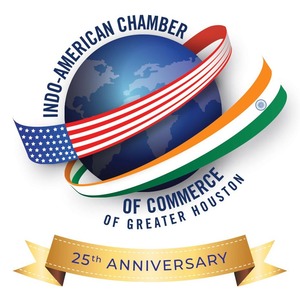Threads of Legacy: MFAH Showcases Rare Indian Textiles from the Parpia Collection
By Somdatta Basu
On a lively Saturday afternoon at the IACCGH Business Hour on Open Forum, featured an hour-long discussion that brought together heritage, craftsmanship, and community pride. The program spotlighted the current exhibition at the Museum of Fine Arts, Houston (MFAH), titled From India to the World: Textiles from the Parpia Collection, and welcomed in-studio guests Amy Poster, Consulting Curator of Asian Art at MFAH, and distinguished collectors Banoo and Jeevak Parpia.
Dr. Subodh Bhuchar, one of the show hosts, set the tone with his signature humor and warmth, noting that while others might be playing golf or running errands, Open Forum listeners were in for a cultural treat. He emphasized India’s ancient contributions to the world — from mathematics and science to its lesser-known but equally rich legacy in textiles. “One of the most important things that India gave to the world was textile,” he noted. “It’s a little-known fact, but amazing.”
Amy Poster shared the background of the exhibit and MFAH’s longstanding relationship with Indian art. “The museum has been collecting Indian art since its founding and has an extraordinary small collection of Indian textiles that came in 1933,” she said. That changed dramatically in 2018 when the museum hosted the Parpias for a lecture. “The rest is history,” Poster noted. “Now that the collection is largely here in Houston, we decided to return to the subject of Indian textiles with a new exhibition.”
The Parpias, based in Ithaca, New York, have been collecting Indian textiles since the 1980s. Jeevak Parpia, a physicist by profession, described how the couple’s interest was sparked by a visit to the Calico Museum in Ahmedabad. “That really inspired us about the beauty of these objects,” he said. Banoo, who trained in physics before earning a Ph.D. in social epidemiology from Cornell, added, “Our interest is what binds us really strongly.”
Dr. Bhuchar pointed out the uniqueness of their passion: “You don’t collect textiles and put them on your wall,” he joked. But the Parpias’ interest is scholarly and deeply emotional. “Textiles, in our opinion, define the Indian aesthetic like no other medium does,” Banoo said. She cited the discovery of fragmentary Indian textiles from Mohenjo-Daro dating back to 7,000 BCE as evidence of this long tradition. “They are depicted in sculpture, in paintings. They’re extraordinary.”
Jeevak added that their appeal also lies in their diversity. “What is produced in India is highly regional, very specialized… That variety and breadth is a wealth.”
The exhibition includes embroidered and woven pieces like kantha, phulkari, court silks, ikats, and tie-dyes, many of which were once used as ceremonial items or even currency. “The British and Dutch East India Companies bought Indian textiles with gold and traded them for spices,” Jeevak explained. These textiles often survived because they were only brought out during special occasions and carefully stored.
When asked if the collection was an investment, Banoo was clear: “Never as an investment. Always for their beauty. We would look at a piece and say — this tells a story. This is something we must have.”
Poster added that the exhibition is already drawing visitors and is deeply resonating with the community. “People came Wednesday, Thursday, Friday. They left their jobs and businesses to learn further,” she said. The collection has been partially acquired and partially gifted to the museum. “Houston has now a promised gift from us,” Banoo confirmed.
The exhibit has also served as a catalyst for community outreach, education, and cultural programming. Poster described MFAH’s efforts to engage children through summer programs in weaving and stitching and adults through lectures, author talks, and upcoming music and dance events tied to textile traditions.
“We are bringing in authors like Chitra Divakaruni, who will return on August 16,” she said. Poster also praised the support of Houston’s South Asian community. “They’ve wrapped themselves around us. It has been just an embrace that we cannot let go.”
As the conversation closed, Poster emphasized the long-term vision: “This collection is now in America. It’s now in Texas and Houston. It could have gone someplace else. But Banoo and Jeevak Parpia decided they wanted it to stay here.”
The exhibition From India to the World: Textiles from the Parpia Collection is on view at the MFAH through September 14, 2025.
